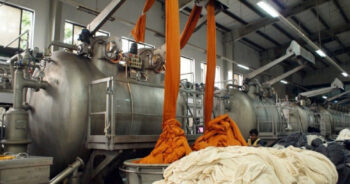 In a distressing turn of events, Wisdom Attires, a prominent apparel manufacturing group in Fatullah, Narayanganj, with a daily dyeing capacity of 25 tonnes, finds itself at the epicentre of a gas crisis. The factories under the group, which were consuming nearly Tk 3 lakh worth of gas daily, have been grappling with near-zero gas pressure since October 15, forcing the group of companies to resort to burning LPG, CNG, and diesel to operate generators. This unprecedented challenge has led to a drastic reduction in production, plummeting from its usual 25-tonne output to a mere 10-12 tonnes per day. Astonishingly, despite this 50 per cent decrease in production, Wisdom Attires now incurs an additional cost of Tk 7 lakh for LPG, CNG, and diesel.
In a distressing turn of events, Wisdom Attires, a prominent apparel manufacturing group in Fatullah, Narayanganj, with a daily dyeing capacity of 25 tonnes, finds itself at the epicentre of a gas crisis. The factories under the group, which were consuming nearly Tk 3 lakh worth of gas daily, have been grappling with near-zero gas pressure since October 15, forcing the group of companies to resort to burning LPG, CNG, and diesel to operate generators. This unprecedented challenge has led to a drastic reduction in production, plummeting from its usual 25-tonne output to a mere 10-12 tonnes per day. Astonishingly, despite this 50 per cent decrease in production, Wisdom Attires now incurs an additional cost of Tk 7 lakh for LPG, CNG, and diesel.
Md Akhter Hossain Apurbo, a director of the Wisdom Attires Group and vice-president of the Bangladesh Knitwear Manufacturers and Exporters Association (BKMEA), expressed his concerns, saying, “Although the gas pressure is non-existent, we are compelled to pay our bills to the Titas authority. The disruption in our supply chain due to the drop in dyeing production has put our factories at risk of missing shipment deadlines. The ongoing economic crisis, coupled with the recent gas shortage, has added to our woes.”
“The government hiked gas prices almost double and committed to ensure uninterrupted supply through LNG import from the spot market. But they did not keep their commitment,” he added.
Fakir Fashion, another significant player in the industry with a daily dyeing capacity of 50 tonnes, is also reeling from the same crisis, even though the factory had previously enjoyed a stable gas supply. Forced to adopt a similar policy to Wisdom Attires, Fakir Fashion has occasionally had to outsource work to other factories. Since the second week of October, numerous factories in Narayanganj have faced a severe gas shortage crisis, leading to hampered production and financial losses running into crores of taka. Surprisingly, despite these challenges, authorities have yet to take decisive action.
Notably, the gas supply situation in the Gazipur area has also witnessed a decline in recent times, though it remains marginally better than the situation in Narayanganj. Industry experts assert that this crisis extends beyond spinning and dyeing mills, creating a domino effect on the entire apparel sector. With millers struggling to meet shipment deadlines, clothing manufacturers are forced to increase yarn and fabric imports, exacerbating Bangladesh’s severe foreign exchange reserve shortage.
Mohammad Ali Khokon, the President of the Bangladesh Textile Mills Association (BTMA), emphasised the industry’s struggle, noting, “Despite a nearly 50 per cent reduction in orders compared to capacity, spinning and dyeing mills cannot operate 24 hours a day due to the gas crisis. The situation in both Narayanganj and Gazipur zones has persisted for an extended period, and despite paying double the price, the authorities have failed to fulfil their commitment to ensuring uninterrupted gas supply.”
Khokon warned that if the situation does not improve, millers may be compelled to shutter factories, with liabilities increasing daily.
Petrobangla, the national energy authority, reported that the current gas demand in the country is around 4000 million cubic feet per day (MMcf/d), while only 2500 MMcf/d is being supplied. Despite having 20 operational gas fields with a total capacity of around 2900 million cubic feet per day, domestic natural gas production has decreased to 2050 MMcf/d.
To address the growing gas demand, the government has been importing LNG since 2018, covering 22 per cent of the demand. However, recent disruptions, including the ongoing renovation of an LNG terminal and increased demand from fertiliser factories, have contributed to the gas shortage.
Petrobangla data shows on Monday this week, two LNG terminals in Maheshkhali have supplied 514 MMcf gas. Although more than 900 MMcf/d gas was supplied in October.
Tariqul Islam Khan, Deputy General Manager of Petrobangla, explained that the LNG terminal owned by US-based Accelerate Energy has been undergoing renovation since November 1, reducing LNG supply.
Petrobangla’s Monday data shows that 799 MMcf/d of gas has been supplied to power plants, 179 MMcf/d to fertilizers and 1524 MMcf/d of gas to industries and other sectors.
In response to the crisis, Anisur Rahman, general manager (Regional Distribution Division Narayanganj) of Titas Gas, attributed the shortage in Narayanganj t to the non-availability of gas as per demand. However, he clarified that Titas Gas only distributes gas and cannot address production-related issues.
The government, with two long-term LNG supply agreements with Qatar and Oman, has also recently signed a fresh LNG supply agreement with Accelerate Energy for imports from the USA.
In the wake of the Ukraine-Russia war and the subsequent surge in spot market LNG prices, the government halted LNG imports in July last year to preserve forex reserves. This decision significantly impacted the textile industry’s production. Industry leaders had recommended an increase in gas prices to Tk 22 per cubic metre to resume LNG imports from the spot market.
Despite this, the crisis persists, posing a serious threat to the textile industry and the broader economy.
The government, however, raised gas prices to Tk 30 per cubic metre for all sectors on January 18 this year from Tk 11.98 for large, Tk 11.78 for medium, and Tk 10.78 for small, cottage and other industries. It said LNG imports from the spot market will increase gas pressure.





















